Schrade SCAXE2L Survival Axe Reviewed

Marketing from Schrade
Whether you are looking for an axe to carry on the job as a first responder, or just to keep in your vehicle or home for emergencies, Schrade has great models at very good prices. Even if it is just for the go-bag, their Large Extreme Survival Axe is really too cool to pass up!
Schrade Large Survival Axe with a strong Titanium coated 3Cr13 Stainless Steel blade and hammer pommel. Features a black glass fiber filled plastic handle with ergonomic black TPR rubber grip. Comes with an extra large ferro rod with lanyard stored inside the handle, round sharpening disc, and black nylon belt sheath.
Manufacturer: Schrade, www.schrade.com
Model: SCAXE2L
Overall Length: 15.7″ (39.9 cm)
Blade Steel: Titanium Coated 3Cr13 Stainless Steel
Blade Length: 4.2″ (10.6 cm)
Handle Material: Black Glass Fiber Filled PA w/ TPR Rubber Grip
Grip Length: 6.8″ (17.3 cm)
Weight: 1.94 lbs
Accessories: XL Ferro Rod, Thermoplastic Sheath, Sharpening Stone
Warranty: Limited Lifetime Warranty against any manufacturing defects
MSRP: $63.00
UPC: 044356220941
The Review
So here we are with another must-have… Whether you are just camping down by the lake with your family, bugging-out or caught in a survival situation, a hatchet or small hand axe can be instrumental for wood processing and shelter building. Sometimes a good survival knife is just not enough to do the job alone, unless that is all you’ve got. But why not plan ahead and make your life easier?
The first survival axe that I’m going to be reviewing for LTS is Schrade’s Survival Axe – SCAXE2L. At nearly 16″ long, the SCAXE2L would be considered a large hand axe so it can be used with either one or two -hands.

Initial Thoughts
From the moment that I first picked up the SCAXE2L I was pretty impressed with the quality and attention to detail that Schrade had put into the design and engineering of this survival axe. Sure it’s not a Gransfors Bruks, Wetterlings or Benchmade, but then again, it doesn’t cost an arm and a leg or your next of kin either.
The Titanium-coated 3Cr13 Stainless Steel head and glass-reinforced handle with a TPR rubberized grip are both stout and sharp-looking. Even the XL ferro rod and the ballistic nylon sheath are not too shabby either.
After wielding it for a few minutes, the SCAXE2L felt like it might be a little on the heavy-side for one-handed operation for any length of time without choking up on the handle. However, it is sized perfectly for two-handed use when you need a more power and control. We’ll have to see if the weight is of any effect during the functional testing.
The only negative I’ve come across at this point is related to the height of the grip. With two hands on the handle, your top hand will likely land one finger or more above the top of the grip. And if you choke way up on the handle for some single-handed operations where you need a lot more control, your hand may also land partially above the grip. If you are wearing gloves, this will not be an issue. But if Schrade would have continued the grip coating just 2-3″ further up the handle, it would have been perfect.
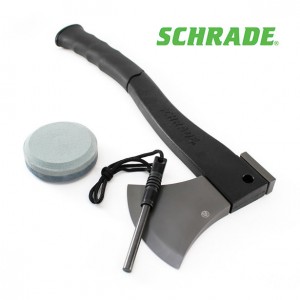 The SCAXE2L came sharp right out of the box. This is one detail (among others) that I love about Schrade products. They always arrive sharp and ready to go. I am always bothered when I pull a knife out and I have to sharpen it before I can try it out. Call it one of my peeves… But is it really too much to ask?
The SCAXE2L came sharp right out of the box. This is one detail (among others) that I love about Schrade products. They always arrive sharp and ready to go. I am always bothered when I pull a knife out and I have to sharpen it before I can try it out. Call it one of my peeves… But is it really too much to ask?
Features
Now lets discuss the SCAXE2L’s features in more detail…
The Axehead
The SCAXE2L’s axehead is made from Titanium-coated 3Cr13 Stainless Steel with a sharpened 4.2″ blade. 3Cr13 Stainless Steel is a very good alloy for an axehead because it is relatively easy to sharpen and holds an edge extremely well. However, 3Cr13 Stainless Steel is only rust resistant, not rust proof. Even with the protective Titanium coating, it is still susceptible to rust without proper care and maintenance. If the blade becomes wet, simply dry it thoroughly and lightly coat it with an oil like Break-Free CLP before storage. If you do, it just might last you a lifetime.
The SCAXE2L also has a milled non-slip hammer pommel on the opposite end of the axehead for hammering anything from nails to stakes, or even crushing rocks.
The Handle
The Stainless Steel head is fused onto a 15.7″ black, glass-fiber filled PA handle with a 6.8″ ergonomic black TPR rubberized grip.
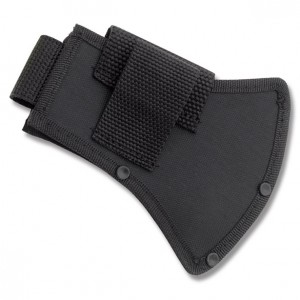 TPR is basically a Thermoplastic Elastomer similar to that of TPE, making it a perfect choice for a handle grip. The TPR surface provides a comfortable, non-slip surface, even in wet conditions. Additionally, the soft TPR material will absorb some of the vibration coming from the axe head as it strikes hard surfaces, thus reducing fatigue.
TPR is basically a Thermoplastic Elastomer similar to that of TPE, making it a perfect choice for a handle grip. The TPR surface provides a comfortable, non-slip surface, even in wet conditions. Additionally, the soft TPR material will absorb some of the vibration coming from the axe head as it strikes hard surfaces, thus reducing fatigue.
The Sheath
The SCAXE2L includes a ballistic nylon sheath to protect the blade when not in use. There is a wide Velcro flap on top of the sheath providing easy access.
Update: It is my understanding that Schrade is now including a molded thermoplastic sheath that provides easier access and better protection when not in use instead of the old nylon sheath. This is one improvement that I’m glad to hear about.
Accessories
The SCAXE2L includes an extra-large Ferro rod with a lanyard that stores firmly inside the handle. The Ferro rod is an excellent size and quality, providing an ample amount of heat and spark with each strike. Perfect for getting a fire going quickly.
A standard double-sided sharpening stone is also included with the axe: one side coarse, the other fine. The stone is about 1″ thick, 3″ in diameter and weighs around 7.6 oz.
Functional Testing
Now lets see what Schrade’s SCAXE2L can do… In order to provide a some sort of apples-to-apples comparison between axes, I will be performing four durability and fine-control tests; Chopping, Log Splitting, Feather Stick and Edge Retention. In a survival situation, all resources are fair game. However, since I am not in a life-or-death situation, I’ll stick to some seasoned logs that I have lying around for these tests. I thoroughly recommend wearing eye protection and a good pair of gloves to protect your hands and absorb some of the vibration.
Chopping
First, I decided try my hand at some bushwhacking techniques by chopping some long branches and limbs into a manageable size like those necessary to build a simple shelter or to create a stockpile of firewood for getting through a cold night.
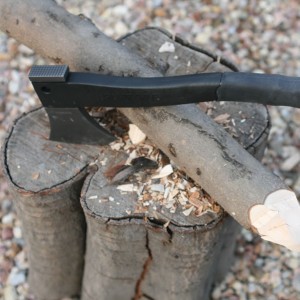 The SCAXE2L made quick work of the smaller branches 1-2″ in size without much effort, many with a single swing. Moving on to larger 4-5″ material obviously required a bit more effort. Due to its two-pound weight and long stroke, the SCAXE2L was able to produce a moderate amount of striking force. When coupled with its extremely sharp edge, I was able to buck four logs rather quickly.
The SCAXE2L made quick work of the smaller branches 1-2″ in size without much effort, many with a single swing. Moving on to larger 4-5″ material obviously required a bit more effort. Due to its two-pound weight and long stroke, the SCAXE2L was able to produce a moderate amount of striking force. When coupled with its extremely sharp edge, I was able to buck four logs rather quickly.
When bucking a log you simply strike the log at a 45° angle from two perpendicular directions along the cut-line, effectively making a “V” where the material used to be otherwise known as the kerf. The kerf should equal the diameter of the trunk, and when cutting from both sides, the kerf would essentially be half diameter.
The size, weight and balance of the SCAXE2L provide an ample amount of force and control when notching and shaping logs. This is a necessity when fitting them tightly together for use in building a shelter or some other bushcraft project.
I was thoroughly impressed with the results. The SCAXE2L performed very well in all aspects of this functional challenge.
Log Splitting
After chopping all of that wood, I am beginning to feel my inner lumberjack come out… For the next test, I think some genuine log splitting is in order.
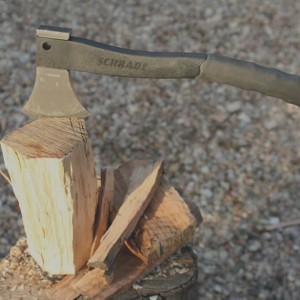 To start, I simply quartered the four 5-6″ x 18″ logs that I had just chopped in the previous test. The SCAXE2L ripped through the logs without much effort, even with all of the the knots that I ran into. Granted, I am using a tall stump in my backyard to split against so the environmental conditions that I am working in are certainly in my favor.
To start, I simply quartered the four 5-6″ x 18″ logs that I had just chopped in the previous test. The SCAXE2L ripped through the logs without much effort, even with all of the the knots that I ran into. Granted, I am using a tall stump in my backyard to split against so the environmental conditions that I am working in are certainly in my favor.
For part two of the challenge, I chose to split a log approximately 12″ diameter and a little less than 12″ tall. Now the SCAXE2L is much too small to quarter a large-diameter log, as with any hand axe or hatchet. You simply cannot use the same method as you would splitting logs 6″ or smaller. The exercise would be futile. Quartering a large-diameter log is really a job for a wedge or splitting maul.
To properly split larger material like this with a hand axe or hatchet, you still strike the axe against the top edge of the log, just not perpendicular to the rings. You must instead align the blade in the same direction as the rings. As a result, you are only removing small sections of the log, just an inch or two thick and maybe 3-4″ wide. As you work your way around the log the diameter will continue to decrease, getting smaller and smaller until it is finally quarterable.
A word of caution when performing a task like this… It can be very dangerous with a short axe. Make sure never to break the vertical plane rule. Avoid any condition where the axe could swing beyond its vertical plane without hitting something other than your leg first. This task is best performed safely from the ground-level, and not from high-up on a stump. Simply place the log you are sectioning on the ground, and kneel in front of it as you section it off.
The SCAXE2L performed very well with this challenge as well. Using two hands coupled with the size, weight and only taking small sections at a time, the SCAXE2L was able to section the log easily.
Feather Stick
Per Wikipedia: A feather stick (sometimes referred to as a fuzz stick) is a length of wood which is shaved to produce a head of thin curls protruding from the wood. It is used for damp wood to start a fire (or campfire) when dry tinder is hard to find.
Next, I thought making a feather stick would provide some insight into how well the SCAXE2L can perform light bushcraft tasks. The SCAXE2L looks to be sharp enough to feather a stick, but how much control will its large size allow?
For this test I used a stick about 1-1/2″ in diameter and about 18″ in length. I began by shaving off the bark from about half-way up the stick exposing the wood grain. Once the bark had been removed, I started to work my way around the stick with short 2-3″ strokes near the bottom-end of the stick. I was creating finely shaved curls otherwise known as “feathers”.
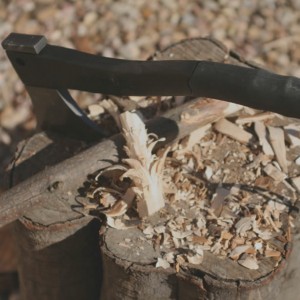 I found that gripping the handle against the bottom of the axehead with my index finger resting on the cheek of the axehead to be the sweet-spot for providing the best control when feathering a stick. Additionally, I rested the grip-end of handle against my thigh to increase my control over the axe.
I found that gripping the handle against the bottom of the axehead with my index finger resting on the cheek of the axehead to be the sweet-spot for providing the best control when feathering a stick. Additionally, I rested the grip-end of handle against my thigh to increase my control over the axe.
As I continued my way up the stick, I tried not to shave the curls too long or dig too deep causing them to break off. However, this was difficult to do with the shape of the blade and large handle. Additionally, I was using a hard wood so it was not nearly as easy as it could have been with a softer material. About 6″ up, I began to work my way around deeper and deeper into the stick until I was almost all the way through. Finally, I snapped the feathered section off leaving what can only be described as a 6″ tall pinecone. While it was a little ugly, I did have a usable feathered stick for starting a fire.
As expected, the SCAXE2L performed fairly well even though the blade is not really designed for this kind fine-work. A good survival knife is certainly better suited for this kind of fine bushcraft. However, in a pinch it will get the job done.
Edge Retention
After all of the functional tests were completed, the SCAXE2L was still able to slice through a single sheet of paper without issue. Additionally, there were no sign of cracks, chips or imperfections of any kind with the exception of some wear on the blade’s protective coating. The SCAXE2L held its edge and remained very sharp the entire time, even with all of the punishment that I threw at it.
Final Thoughts
I really enjoyed putting the SCAXE2L to the test. I found it to be a rock-solid performer. The SCAXE2L is undoubtedly a versatile hand axe, pack-axe or sidearm for your utility belt. It is tough enough to get the job done, even under the most extreme survival conditions. The 3Cr13 Stainless Steel axehead and glass-reinforced handle are rust resistant and seemed to be virtually indestructible, so you know it’s built last. And with its sub-$45 price tag, you really get a lot of bang for your buck with this one.
As I stated previously, I am hopeful that Schrade will consider continuing the grip coating 2-3″ further up the handle in a future update. This would greatly improve the ergonomics with two-handed operations when you aren’t wearing gloves.
My only real concern with the SCAXE2L is that it might be a little on the heavy-side for those long treks where every cubic inch and ounce carried do matter. Under those circumstances, the SCAXE2 may be a better choice. The half-pound difference could equate to a day or more worth of food by weight, or a spare water filtration device. As a result, I feel it is important for me to see how the smaller and lighter SCAXE2 stacks up against the SCAXE2L under similar conditions.
So if you are prepping on a budget, the SCAXE2L is a great value. You can get four of them for the same cost as many of the high-end alternatives, and likely never discover any of the benefit. Schrade stands behind their products with a Limited Lifetime Warranty against any manufacturing defects for as long as you own it.
You can find this and other Schrade products here: http://amzn.to/2c0kjZF
![]()
About Taylor Brands and Schrade Cutlery
 Founded by Stewart Taylor in 1975, Taylor Brands has been manufacturing, designing, and distributing high-quality stainless steel cutting tools and accessories since our inception. Taylor Brands owns and produces Schrade, Old Timer, Uncle Henry, and Imperial branded products, and are also licensed to produce multiple product lines under the world famous Smith & Wesson brand. In total Taylor Brands manufactures several hundred different products including fixed and folding knives, collapsible batons, tactical pens, handcuffs, tactical and survival accessories, and flashlights.
Founded by Stewart Taylor in 1975, Taylor Brands has been manufacturing, designing, and distributing high-quality stainless steel cutting tools and accessories since our inception. Taylor Brands owns and produces Schrade, Old Timer, Uncle Henry, and Imperial branded products, and are also licensed to produce multiple product lines under the world famous Smith & Wesson brand. In total Taylor Brands manufactures several hundred different products including fixed and folding knives, collapsible batons, tactical pens, handcuffs, tactical and survival accessories, and flashlights.
--